Discoveries
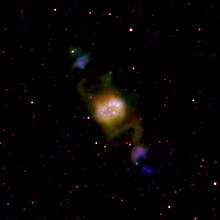
The survey has already discovered a large number of previously unknown planetary nebulae, such as the Necklace Nebula in this image.
| Alternative names | IPHAS |
|---|---|
| Website | www |
The INT Photometric H-Alpha Survey (IPHAS) is an astronomical survey of the northern plane of our Galaxy, the Milky Way, as visible from the Isaac Newton Telescope (INT) in the Canary Islands, Spain. [1] The survey uses two broad-band filters and a narrow H-alpha filter to obtain deep images of nebulae in our Galaxy and for identifying rare types of stars. Observations for the survey began in 2003 and are almost complete. The survey is being complemented by a sister survey of the southern Galactic Plane, VPHAS+. [2] Once these two surveys are completed the data are expected to provide a significant leap in our knowledge of the extreme phases of stellar evolution.
The goals of the survey include:
Because of the selection for young stars and nebulae, the survey will also increase the number of known OB associations, and other clusters.

The survey has already discovered a large number of previously unknown planetary nebulae, such as the Necklace Nebula in this image.

A planetary nebula is a type of emission nebula consisting of an expanding, glowing shell of ionized gas ejected from red giant stars late in their lives.

Seyfert galaxies are one of the two largest groups of active galaxies, along with quasar host galaxies. They have quasar-like nuclei with very high surface brightnesses whose spectra reveal strong, high-ionisation emission lines, but unlike quasars, their host galaxies are clearly detectable.

In astronomy, photometry, from Greek photo- ("light") and -metry ("measure"), is a technique used in astronomy that is concerned with measuring the flux or intensity of light radiated by astronomical objects. This light is measured through a telescope using a photometer, often made using electronic devices such as a CCD photometer or a photoelectric photometer that converts light into an electric current by the photoelectric effect. When calibrated against standard stars of known intensity and colour, photometers can measure the brightness or apparent magnitude of celestial objects.

Spiral galaxies form a class of galaxy originally described by Edwin Hubble in his 1936 work The Realm of the Nebulae and, as such, form part of the Hubble sequence. Most spiral galaxies consist of a flat, rotating disk containing stars, gas and dust, and a central concentration of stars known as the bulge. These are often surrounded by a much fainter halo of stars, many of which reside in globular clusters.

The Zone of Avoidance, or Zone of Galactic Obscuration (ZGO), is the area of the sky that is obscured by the Milky Way.

Messier 58 is an intermediate barred spiral galaxy with a weak inner ring structure located within the constellation Virgo, approximately 68 million light-years away from Earth. It was discovered by Charles Messier on April 15, 1779 and is one of four barred spiral galaxies that appear in Messier's catalogue. M58 is one of the brightest galaxies in the Virgo Cluster. From 1779 it was arguably the farthest known astronomical object until the release of the New General Catalogue in the 1880s and even more so the publishing of redshift values in the 1920s.

Messier 90 is an intermediate spiral galaxy exhibiting a weak inner ring structure about 60 million light-years away[a] in the constellation Virgo. It was discovered by Charles Messier in 1781.
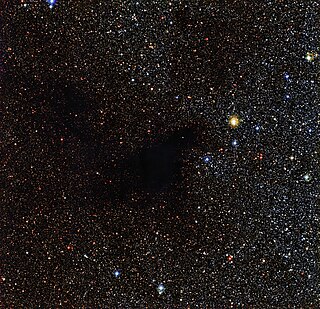
In astronomy, extinction is the absorption and scattering of electromagnetic radiation by dust and gas between an emitting astronomical object and the observer. Interstellar extinction was first documented as such in 1930 by Robert Julius Trumpler. However, its effects had been noted in 1847 by Friedrich Georg Wilhelm von Struve, and its effect on the colors of stars had been observed by a number of individuals who did not connect it with the general presence of galactic dust. For stars lying near the plane of the Milky Way which are within a few thousand parsecs of the Earth, extinction in the visual band of frequencies is roughly 1.8 magnitudes per kiloparsec.

An astronomical survey is a general map or image of a region of the sky that lacks a specific observational target. Alternatively, an astronomical survey may comprise a set of images, spectra, or other observations of objects that share a common type or feature. Surveys are often restricted to one band of the electromagnetic spectrum due to instrumental limitations, although multiwavelength surveys can be made by using multiple detectors, each sensitive to a different bandwidth.

NGC 2022 is a planetary nebula in the equatorial constellation of Orion, located at a distance of 8.21 kilolight-years from the Sun. It was first observed by William Herschel on December 28, 1785, who described it as: considerably bright, nearly round, like a star with a large diameter, like an ill-defined planetary nebula. In medium-sized amateur telescopes it looks like a small grayish patch of light. It is not very bright but it is still easy to spot it in the eyepiece. Even in a telescope as small as 80mm it can just be seen using a narrowband filter such as an OIII filter as a 'fuzzy' star. The object has the shape of a prolate spheroid with a major to minor axis ratio of 1.2, an apparent size of 28″, and a halo extending out to 40″, which is about the angular diameter of Jupiter as seen from Earth.

Sextans B is an irregular galaxy that may be part of the Local Group, or lie just beyond it. Sextans B is 4.44 million light-years away from Earth and thus is one of the most distant members of the Local Group, if it is indeed a member. It forms a pair with its neighbouring galaxy Sextans A. It is a type Ir IV–V galaxy according to the galaxy morphological classification scheme. Sextans B may also be gravitationally associated with the galaxies NGC 3109 and the Antlia Dwarf.
Stewart Sharpless was an American astronomer who carried out fundamental work on the structure of the Milky Way galaxy.
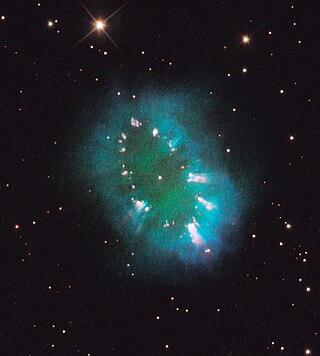
The Necklace Nebula is a 19-trillion-kilometre-wide planetary nebula located about 15,000 light-years away in the northern constellation Sagitta. It was discovered in 2005 from the Isaac Newton Telescope Photometric H-alpha Survey (IPHAS), a ground-based H-alpha planetary nebula study of the North Galactic Plane.
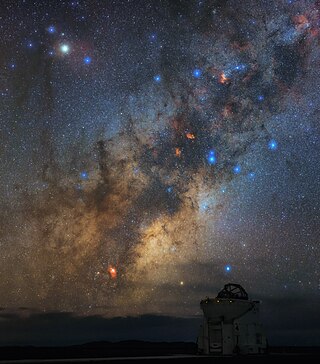
WR 93b is a Wolf-Rayet star in the constellation Scorpius, an extremely rare star on the WO oxygen sequence. It appears near NGC 6357 in the tail of the scorpion.
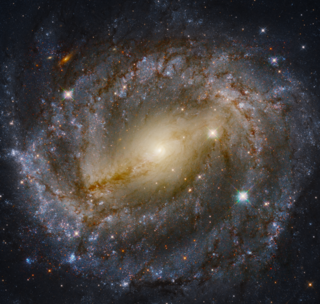
NGC 5643 is an intermediate spiral galaxy in the constellation Lupus. Based on the tip of the red-giant branch distance indicator, it is located at a distance of about 40 million light-years. NGC 5643 has an active galactic nucleus and is a type II Seyfert galaxy.

NGC 2527 is an open cluster in the constellation Puppis. It was discovered by William Herschel on December 9, 1784. The cluster was also observed by John Herschel on January 7, 1831. He also observed it on February 5, 1837, identifying it as a different object, which was catalogued as NGC 2520. It is a poor cluster and with no central concentration, with Trumpler class III1p.
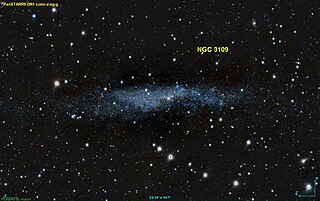
The Antlia-Sextans Group is a small Galaxy group in the constellations Hydra, Sextans, Antlia and Leo. It is, on average, approximately 4.3 million light-years away from the Milky Way. It is generally considered to be at the very edge of the Local Group and thus part of it. However, other researchers indicate it is an independent Galaxy group, unlikely to be gravitationally bound to the Local Group due to probably lying outside the Local Group's Zero-velocity surface, and thus the nearest Galaxy group to the Local Group rather than a subgroup within the Local Group. Nonetheless—this possible independence may disappear as the Milky Way continues coalescing with Andromeda due to the increased mass, and density thereof, plausibly widening the radius of the Zero-velocity surface of the Local Group.

NGC 864 is a star-forming barred spiral galaxy located in the Cetus constellation. It's also classified as an isolated galaxy on the AMIGA catalogue as CIG 96. Its discovery and first description was realized by William Herschel in October 25th, 1785 and the findings made public through his Catalogue of Nebulae and Clusters of Stars, published in 1786.